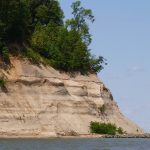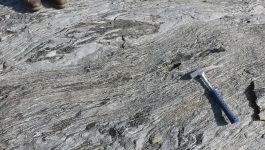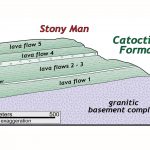
The Rappahannock River forms a broad estuary as it flows to towards the Chesapeake Bay in Virginia’s Coastal Plain province. To the south the Piankatank River is also visible. The Rappahannock and Piankatank rivers are tidal estuaries.
A Resource for Information on the Commonwealth's Geology

The Rappahannock River forms a broad estuary as it flows to towards the Chesapeake Bay in Virginia’s Coastal Plain province. To the south the Piankatank River is also visible. The Rappahannock and Piankatank rivers are tidal estuaries.

The Cliffs of Westmoreland rise 30 to 45 meters (~100 to 150′) above the waters of the Potomac River. These bluffs expose Miocene to Pliocene sedimentary units, some which are quite fossiliferous. For more information on the geology of Westmoreland checkout the 2005 Virginia Geological Field Conference guidebook by Buck Ward and others. Note the […]

This exposure in a pasture near Cuckoo exposes a poly-deformed hornblende and plagioclase-rich gneiss. Foliation in the gneiss has been refolded. Another interesting feature is the presence of garbenschiefer or “feather amphibolite.” This unusual texture is defined by stellate and featherlike hornblende clusters in the plane of foliation. Three amphibole species occur in this rock […]

Many of the highest peaks in Shenandoah National Park (including Hawksbill, Stony Man, and Hightop Mountain, just to name a few) are underlain by distinctive bluish-green rocks that were once ancient lava flows (Virginia is for Lavas!), and are part of a geologic unit known as the Catoctin Formation. From the presidential retreat at Camp David to Jefferson’s […]
Copyright © 2025 · Backcountry Child Theme on Genesis Framework · WordPress · Log in